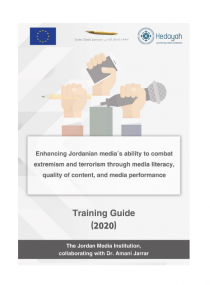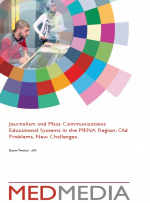Image:

17 Jan 2017
Amman, 15 January (JMI) -- A research study has called for giving attention to social media networks, particularly Facebook, and the material posted on these sites in view of their importance in accessing news on various topics and directing it to serve national issues. The study, titled Role of Facebook and Twitter in Building Political Culture of Students of University of Jordan and Middle East University 2011-2015, noted the great impact of social media networks on shaping political opinions of youth. The study, conducted by Ahmad Al Tarifi, was debated at JMI today to obtain the MA degree. It underlined the need for further studies related to interaction on social media networks, which could have a greater effect than the main news stories on shaping opinions and political culture.<br />
<br />
The study, supervised by Dr. Jamal Shalabi, concluded that one third of the students who were surveyed depend on social media networks for political information and that the majority of students obtain information for cultural purposes and to get to know the ideas of the entities that publish this information.<br />
<br />
The study revealed that social media networks play an important role in shaping political culture. These networks are the instrument that has the greatest impact on increasing interaction between individuals. This interaction raises the awareness of individuals of events and news and enables them to express opinions and ideas about them. <br />
<br />
The study underlined the high impact of Facebook and Twitter on building political culture. The results showed that these networks contribute toward increasing political culture on university campus. Facebook and Twitter stimulated students to be involved in local, Arab and international politics. Social media networks contribute to building political culture by around 42.9%, judging by the student sample. <br />
<br />
The study also showed that the majority of students depend on social media networks to get political news. <br />
<br />
In a related development, a research study titled "Jordanian Question in Pan-Arab Press: Study of Content Analysis" concluded that security and political issues dominated the coverage of the pan-Arab press of Jordanian affairs and that its greatest focus was on "terrorism issues." The study, conducted by Ali Shamaileh and debated at JMI to obtain the MA degree, monitored the content of the pan-Arab press of Jordanian issues through the published material of the two pan-Arab newspapers Al Quds Al Arabi and the London-based Al Hayat, in their online versions, as a sample that represents the population study between August 2014 and August 2015. The sample of the study included 2,409 items published by the two newspapers during this period. <br />
<br />
The study, which is considered one of the first local academic studies on pan-Arab newspapers and analysis of their content in relation to Jordanian affairs, was supervised by JMI Dean Dr. Basim Tweissi. It showed that while Al Quds Al Arabi focused on issues pertaining to "Jordan's domestic politics," the London-based Al Hayat focused more extensively on "refugee issues and affairs." As for economic content, Al Hayat published 24.1% of the sample of the study versus 8.4% published in Al Quds Al Arabi. For social content, both newspapers were close as Al Quds Al Arabi published 21%, while Al Hayat published 19.1%. <br />
<br />
As for the sources of items, Al Quds Al Arabi, depended on "press writer" as a main source by 35.9%, while Al Hayat depended on "reporter or correspondent" as a main source by 33.4%. <br />
<br />
The two newspapers did not give prominence to any person, be it natural or legal, as a specific or active personality in any of their editorial material. The prevailing trend in subjects of both newspapers vis-à-vis Jordanian affairs was neutral by around 81.4%. <br />
<br />
As for the means used to illustrate news, pictures were almost solely used by the two newspapers by 95.7%. Most of the pictures used in the material of the two newspapers were archival. The study found that both newspapers largely fell short when it comes to graphics, videos, and electronic media applications, which did not exceed 4.3%. <br />
<br />
It is worth noting that the scientific importance of this study lies in that its results will motivate local researchers in the field of journalism and media to do further research and studies related to pan-Arab newspapers and to evaluate their journalistic and professional practices toward Jordan. <br />
<br />



